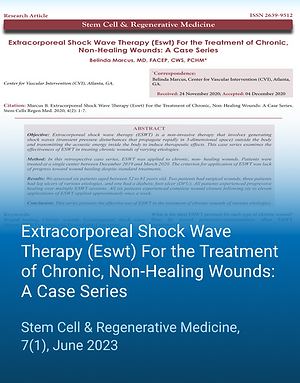
Regenerative Medicine of Tomorrow
Scientific Insights into Spark Wave®
Therapy Applications
Wounds and Scars
ESWT Improves Blood Supply & Promotes Tissue Formation
Wound healing is a complex biological process that occurs in four distinct phases:
Coagulation & Haemostasis:
Formation of a blood clot to stop bleeding.
Inflammation:
Immune system response to prevent infection and clear deposits.
Proliferation / Granulation:
New tissue generation as cells multiply and rebuild the wound bed.
Tissue Remodeling & Epithelialization:
Strengthening of the wound and formation of scar tissue.

Bleeding and Hemostasis

Inflammation

Proliferation

Remodeling
4 phases of wound healing. Modified after Fadilah et al., 2022
These stages depend on effective cell-to-cell communication, a steady nutrient supply and healthy blood circulation. In chronic wounds, these phases are disrupted, leading to persistent inflammation and impaired tissue regeneration. Spark Wave Therapy supports and accelerates these natural healing processes by modulating inflammation, stimulating proliferation and supporting the remodelling phases at the molecular level.
How ESWT Supports Wound Healing and Scar Formation:
Accelerated Wound Closure:
Increases cell metabolism and ATP release for faster cellular energy production.
Enhances cell proliferation for rapid tissue formation.
Optimizes the inflammatory balance of molecules to promote effective healing.
Stimulates angiogenesis (formation of new blood vessels) to improve oxygen and nutrient delivery.
Scar Tissue Improvement and Symptom Relief:
Reduces pain, itching, and skin tension associated with scars.
Improves scar appearance through collagen stimulation and remodeling.
Restores tissue elasticity and flexibility.

Schematic presentation of the cellular signaling pathways after ESWT: increase of ATP, activation of the MAPK/MEK pathway, and initiation of downstream biological processes.
Modified after Szwarc-Hofbauer et al. 2025.
Key Benefits
Shortened wound healing time
Improved scar quality and appearance
Reduced discomfort and increased skin elasticity
Non-invasive, safe, and drug-free therapy
References
-
Basoli, V., Chaudary, S., Cruciani, S., Santaniello, S., Balzano, F., Ventura, C., Redl, H., Dungel, P., & Maioli, M. (2020). Mechanical stimulation of fibroblasts by extracorporeal shock waves: Modulation of cell activation and proliferation through a transient proinflammatory milieu. Cell Transplant 2020, 29, 096368972091617.
-
Mittermayr, R., Hartinger, J., Antonic, V., Meinl, A., Pfeifer, S., Stojadinovic, A., Schaden, W., & Redl, H. (2011). Extracorporeal shock wave therapy (ESWT) minimizes ischemic tissue necrosis irrespective of application time and promotes tissue revascularization by stimulating angiogenesis. Annals of Surgery 2011, 253 (5), 1024–1032.
-
Chen, R.F., Chang, C.H., Wang, C.T., Yang, M.Y., Wang, C.J., & Kuo, Y.R. (2019). Modulation of vascular endothelial growth factor and mitogenactivated protein kinaserelated pathway involved in extracorporeal shockwave therapy accelerate diabetic wound healing. Wound Repair and Regeneration, 27(1), 69–79.
-
Stojadinovic, A.; Elster, E. A.; Anam, K.; Tadaki, D.; Amare, M.; Zins, S.; Davis, T. A. Angiogenic Response to Extracorporeal Shock Wave Treatment in Murine Skin Isografts. Angiogenesis 2008, 11 (4), 369–380
-
Chuangsuwanich, A.; Kongkunnavat, N.; Kamanamool, M.; Maipeng, G.; Kamanamool, N.; Tonaree, W. Extracorporeal Shock Wave Therapy for Hypertrophic Scars. 49 (4).
-
Fadilah NIM, Maarof M, Motta A, Tabata Y, Fauzi MB. The Discovery and Development of Natural-Based Biomaterials with Demonstrated Wound Healing Properties: A Reliable Approach in Clinical Trials. Biomedicines. 2022 Sep 8;10(9):2226.
-
Szwarc-Hofbauer, D.; Simböck, E.; Hromada, C.; Stoiber, M.; Tomasch, J.; Weitzer, G.; Teuschl-Woller, A. Purinergic Receptors Play a Key Role in Shock Wave-Induced Proliferation. Sci Rep 2025, (1), 19138.
Intended for use by healthcare professionals only and Indications are approved under MDD 93/42/EEC. Product availability, regulatory approvals, and certifications may vary by country. For detailed information regarding local availability and regulatory status, please contact your local sales representative.

MTS Medical is member of




